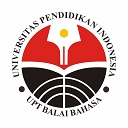Gengobot: Chatbot application to enhance N4 Level Students’ Japanese grammar ability
Abstract
Keywords
Full Text:
PDF (IND)References
Allen, S. J. (2007). Adult learning theory and leadership development. Leadership Review, 7, 26-37. Diakses dari http://www.leadershipreview.org/2007spring/article1.pdf
Aunurrahman. (2014). Belajar dan Pembelajaran. Bandung: Alfabeta.
Cresswell, J. W. (2014). Research Design: Qualitative, Quantitative, and Mixed Methods Approaches. Singapore: Sage Publication.
Baudart, G., Hirzel, M., Mandel, L., Shinnar, A., & Siméon, J. (2018). Reactive chatbot programming. Proceedings of the 5th ACM SIGPLAN International Workshop on Reactive and Event-Based Languages and Systems, 21-30. https://doi.org/10.1145/3281278.3281282
Bloom, B. S., Engelhart, M. D., Furst, E. J., Hill, W. H., & Krathwohl, D. R. (1956). Taxonomy of Educational Objective the Classification of Educational Goals Handbook 1: Cognitive Domain. New York: David McKay Company.
Irham, M., & Wiyani, N. A. (2017). Psikologi Pendidikan: Teori dan Aplikasi dalam Proses Pembelajaran. Yogyakarta: Ar-Ruzz Media.
Jia, J. (2009). CSIEC: A computer assisted english learning chatbot based on textual knowledge and reasoning. Knowledge-Based Systems, 22(4), 249-255. https://doi.org/10.1016/j.knosys.2008.09.001
Judiasari, M. D. (2015). Drill Bunpo Berbasis Multimedia untuk Meningkatkan Kompetensi Bahasa Jepang. Barista, 2(1), 70-79. Diakses dari https://stp-bandung.ac.id/ejournal/index.php/v01/article/view/37/33
Kukulska-Hulme, A. (2012). Mobile‐Assisted language learning. The Encyclopedia of Applied Linguistics, 1-9. https://doi.org/10.1002/9781405198431.wbeal0768
Levy, M. (2009). Technologies in Use for Second Language Learning. The Modern Language Journal, 93, 769-782. Diakses dari https://www.jstor.org/stable/25612273
LINE Indonesia. (2017). Belajar Membangun LINE Chatbot. Diakses dari https://www.dicoding.com/academies/32
Sastranegara, J. P. (2017). Peranan tes kuis dalam meningkatkan pembelajaran memahami tata bahasa Jepang tingkat dasar. Jurnal Pendidikan Bahasa dan Sastra, 17(1), 127-136. DOI: 10.17509/bs_jpbsp.v17i1.6965
Sudjianto, & Dahidi, A. (2017). Pengantar Linguistik Bahasa Jepang. Jakarta: Kesaint Blanc.
Sudjiono, A. (2010). Pengantar Statistik Pendidikan. Jakarta: Ja Grafindo.
Thorndike, E. L. (1927). The law of effect. The American Journal of Psychology, 39(1/4), 212-222. https://doi.org/10.2307/1415413
Traxler, J. (2009). Current state of mobile learning. In M. Ally, Mobile Learning: Transforming the Delivery of Education and Training (pp. 9-24). Edmonton: AU Press.
Wang, Y. F., & Petrina, S. (2013). Using learning analytics to understand the design of an intelligent language tutor – Chatbot Lucy. International Journal of Advanced Computer Science and Applications, 4(11), 124-131. DOI: 10.14569/IJACSA.2013.041117
Yuberti, Y. (2014). "Penelitian dan Pengembangan" yang belum diminati dan perspektifnya. Jurnal Ilmiah Pendidikan Fisika Al-Biruni, 3(2), 1-15. Diakses dari Docplayer.
Zhou, M., & Brown, D. (2015). Educational Learning Theories: Second Edition. Georgia: Galileo, University System of Georgia.
DOI: https://doi.org/10.17509/japanedu.v5i2.30428
Refbacks
- There are currently no refbacks.
Copyright (c) 2020 JAPANEDU: Jurnal Pendidikan dan Pengajaran Bahasa Jepang

This work is licensed under a Creative Commons Attribution-ShareAlike 4.0 International License.
 Published by:
Published by: Department of Japanese Language Education, Faculty of Language and Literature Education
Universitas Pendidikan Indonesia
 Online ISSN: Online ISSN:2528-5548 |

JAPANEDU: Jurnal Pendidikan dan Pengajaran Bahasa Jepang (e-ISSN:2528-5548) lisenced under a Creative Commons Attribution-ShareAlike 4.0 Internasional (CC BY-SA 4.0)


